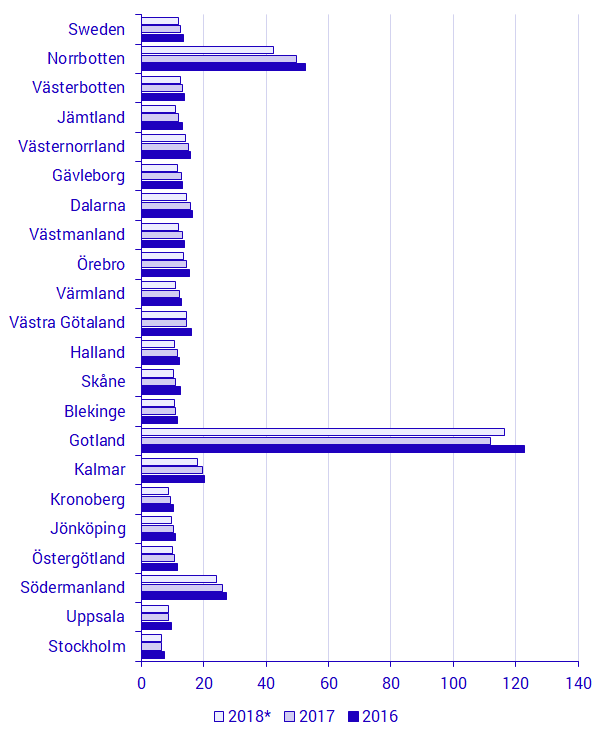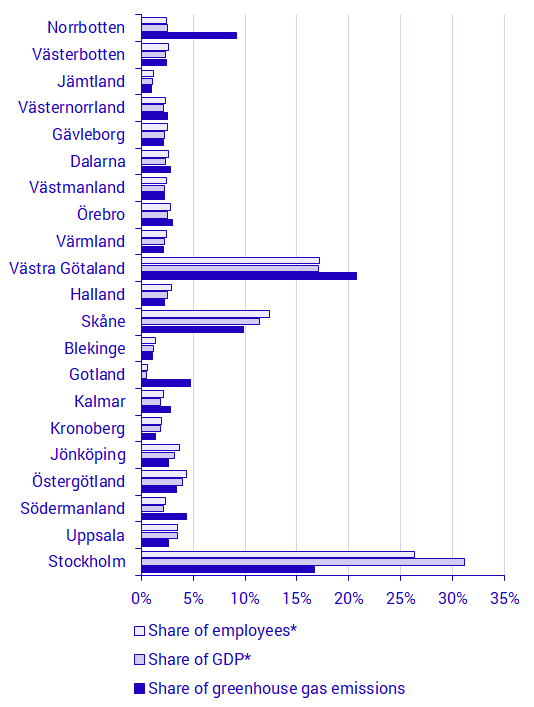Environmental accounts – Emissions to air 2018, regional statistics
Major regional differences remain in greenhouse gas emission intensities
Statistical news from Statistics Sweden 2020-11-04 9.30
Greenhouse gas emissions in Sweden in relation to GDP, also called emission intensity, vary at the regional level. Gotland is the most emission-intensive county and Stockholm is the least emission-intensive county. Between 2017 and 2018, emission intensity decreased in most counties, while it increased in Gotland.
Emission intensity fell in most counties between 2017 and 2018, except in Gotland, where it rose, and a few counties (Stockholm, Uppsala, Blekinge and Västra Götaland) where the emission intensity remained unchanged. Gotland remains the most emission-intensive county; the bulk of greenhouse gas emissions from Gotland’s economy arise from the manufacture of products with large process emissions, even though the largest contributions to Gotland’s economic production come from the service industry and the public sector.
The largest emission intensity reduction between 2017 and 2018 was noted in Norrbotten County. Norrbotten is the county with the second highest emission intensity after Gotland. Stockholm was the least emission-intensive county in 2018.

* The 2018 gross regional product is preliminary.
Environmental economic profile by county
An environmental economic profile can be used to provide a general description of a county’s environmental economic structure. This profile shows the county’s share of Sweden’s GDP, greenhouse gas emissions and employees.
In many counties, the share of greenhouse gas emissions is roughly the same as the share of employees and the share of gross domestic product (GDP). Västra Götaland, Norrbotten, Södermanland, and Gotland, on the other hand, have emission-intensive profiles, in which the share of greenhouse gas emissions is larger than the share of employees and GDP. This is due to emission-intensive industries and numerous shipping companies in these counties.
In Västra Götaland, levels of output of both goods and services are high. This leads to a high share of employees, GDP and greenhouse gas emissions. Meanwhile, in Norrbotten, the share of employees and GDP are smaller, but the share of greenhouse gas emissions is high. This is due, in part, to the presence of manufacturing industries with high emissions and few employees.
In Stockholm County, there is a high share of employees and contributions to GDP. The largest industries in Stockholm County are located in the service sector, in which levels of greenhouse gas emissions are relatively low.

* The 2018 gross domestic product and employees are preliminary data.
Definitions and explanations
Environmental Accounts publishes regional emissions to air per industrial sector at regional, county and municipal level. The statistics include emissions, emission intensities and environmental economic profiles. The statistics follow the framework of the national accounts, which means the emissions are linked to the economic activity responsible for the emissions. Emissions are linked to the economic activity responsible for the emissions, which does not necessarily imply that the emissions actually took place in a specific region, but rather that the actor responsible for the emissions is located there.
The Environmental Accounts are compiled according to the framework of the System of Environmental and Economic Accounts (SEEA) and show national environmental statistics and economic statistics in the same framework using NACE industry classification. The starting point is Swedish economic actors’ environmental pressures, irrespective of where in the world they occur.
Therefore, a residence adjustment is applied to adjust statistical sources with a territorial perspective used to produce these statistics to the national and environmental accounts’ economic perspective. The residence adjustment applies primarily to transport: heavy duty road transport (primarily within H49 land transport companies, but also in other industries, such as construction), water transport (H50) and air transport (H51). Further information about the residence adjustment can be found in the document concerning the quality of the statistics on the Environmental Accounts webpage. These statistics are also explained in more detail in the Environmental Accounts Statistical Report 2017:2 Regional Environmental Accounts 2008–2015.
These statistics on air emissions are reported based on a production perspective. Emissions are reported for the industry from which emissions occur. Indirect emissions from imports and other consumption of goods and services are not included.
Regional statistics on air emissions reported by the Swedish EPA refer to territorial emissions, that is, emissions that occur within the boundaries of each region. This means that the Swedish EPA statistics can be used to monitor air pollution levels in a specific area.
Next publishing will be
The next publication of regional statistics on air emissions is scheduled for the autumn 2021.
Statistical Database
More information is available in the Statistical Database
Feel free to use the facts from this statistical news but remember to state Source: Statistics Sweden.
